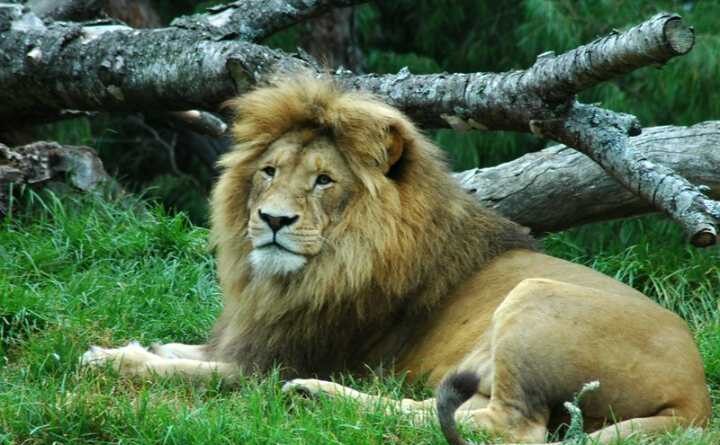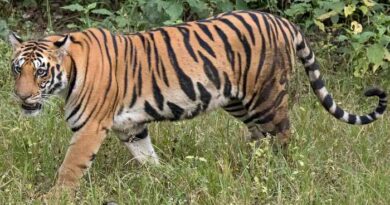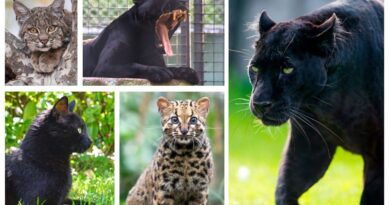The Secret Lives of Lions: A Fascinating Glimpse into the Wild
Introduction: Discover the hidden world of lions, where the king of the jungle reveals surprising traits that make it more dog-like than you might think. From their group hunting strategies to family dynamics, and even the challenges they face in the wild, this article unveils the captivating life of lions.
Body:
- Group Living and Hunting:
- Unlike your typical cat, lions are social creatures that live in groups called prides.
- Learn how these majestic animals collaborate during hunts, with females taking the lead in capturing prey.
- Explore the dynamics of the pride, consisting of adult females, cubs, and a few adult males, and how they work together for survival.
- Hunting Tactics:
- Delve into the intricate strategies employed by lionesses during hunts, including stealthy approaches and coordinated movements.
- Witness the breathtaking speed and teamwork as they circle their prey, showcasing a dynamic and strategic approach to securing their next meal.
- Family Life:
- Uncover the heartwarming side of lions as they spend their waking hours playing with cubs.
- Understand the harsh reality of lion hierarchy, where new males taking over a pride lead to a tragic fate for existing cubs.
- Survival Challenges:
- Lions face challenges from rival males, and their iconic manes play a crucial role in defending their territory.
- Explore the hardships faced by lone lions, forced to adapt to a solitary life and hunt less elusive prey.
- Vocalization and Communication:
- Decode the language of lions, from the intimidating roars that mark their territory to soft grunts used for communication.
- Discover the unique ways lions express emotions, such as purring when content and growling when angry or ready for a fight.
- Conservation and Global Presence:
- Gain insights into the historical decline of lions in various parts of the world due to hunting and human activities.
- Learn about conservation efforts, including the success story of the Gir Forest in India, where a small population of Asian Lions perseveres.
The Life Cycle of Lion in Details:
Even though the lion is the most well-known cat, it is not very cat-like in the way it lives. A typical cat lives in thick undergrowth, hunts on its own, and lives alone. A typical dog lives in a more open area, hunts in a group, and has a lot of friends. In these ways, the lion is more like a dog than a cat. It likes open grasslands, hunts in a group, and lives in a pride of ten to thirty animals.
Usually, there are between five and ten adult females with their cubs and a few adult males in a pride. Most of the hunting is done by the females. Most fights are between males. The cubs spend most of their waking hours playing. When there is plenty of food, life is easy, and everyone is happy. He spends a lot of his time sleeping and resting. People sleep half as long as lions do. Most nights, we need about eight hours of night. Out of every twenty-four, a lion will sleep for a total of sixteen hours. Unlike us, most of this sleeping happens when it’s hot out. As the sun goes down, pride rises up. In the half-light, the lionesses leave their young cubs and go prey. They all work together. When they see a herd of antelopes, they start to move. They come out from the side and slowly move toward them. The hunters’ sand-colored bodies almost blend in with the long, dry grasses on the African plains. Their eyesight is very good, and they watch the herd eat with great care. The antelope stops eating and looks up in fear. When the lionesses think danger is close, they all stop in their tracks. They lower their bodies as far as they can. As they hide in the bunches of grass, they keep their eyes on their prey and don’t move at all. The antelope sniffs the air to try to find a killer’s scent. If it doesn’t do that, it goes back to feeding again. At this point, all of the female lions start to move forward again. The lionesses move at different speeds as they move forward little by little. The ones in the middle of the group move more slowly.
The ones on the left and right move faster than the ones in the middle. The result of this is that they start to circle their prey. This is how wolves sometimes catch their hunting. When they are as close as they can get, they leave their hiding places and run at their victims, leaping at nearly 40 miles per hour. The antelope panic and run in all directions. Now, each lioness works on her own to find a specific antelope, knock it to the ground with a strong paw, and grab its neck with her powerful jaws. At this point, the hunters don’t pay much attention to their companions, but they still help each other a lot. This is because the prey animals see attacks coming from different directions at the same time and get confused, not knowing which way to turn. This disorder is good for the hunters. If the herd of antelopes could run away in a more organised way, with all the animals running as fast as they could in the same direction, they could easily outrun the lions. Almost every big animal that lions eat is faster than them, sometimes by as much as 10 miles per hour. So the best chance to attack is with a group. Even so, lions are only successful in about one out of every four hunts.
When the prey is caught, a bite to the throat stops the animal from breathing and holds it down. The antelope dies in a quiet moment. The pride starts eating again after a short break. The females divide the meat among themselves. If one of the big males comes to check out the kill, he will also eat his fill. If the prey is big enough, like a big antelope, zebra, or buffalo, there will be enough food for everyone. In almost no time at all, the lions’ bellies get big and round. Then they have to rest again, giving their bodies time to digest the fresh meat and wash the blood off their faces and paws. Soon, they fall asleep again, and after a few hours, when they are thirsty, they all leave together to go to the nearest water-hole.
Lions usually rest on the ground, but when it is very hot, they sometimes look for a place higher up where they might get a breeze. Most of the time, they sleep on top of a rocky outcrop or in the lower branches of a tree. This helps them stay cool and gives them a good place from which to watch. The pride’s males have to keep an eye out for other, younger males who might be looking for a group of females to call their own. If the younger males think they can scare off the older males who own the pride, they will threaten them and fight them if they have to in order to take over the pride. Most of the time, the pride males will drive away the intruders, but sometimes things change. If the pride owners are getting too old or have been hurt, the newcomers might be able to beat them. During these fights, the males’ long, black manes are very important. Not only do these protect the animals’ necks from blows, but they also make the lions look bigger and scarier to their enemies.
The manes with lots of hair are perfect because they make the lions bigger without making them much heavier. If the males got any bigger, they would be too clumsy, but the long, black hairs on their mane make them look huge even though they don’t add much weight. If the new males win their fight, the first thing they do as the new leaders of the pride is kill and eat all the young cubs. Since the old males are gone, these cubs are theirs. The new males don’t want to waste their time taking care of the cubs of other fathers.
As a result of this killing of the cubs, the females stop giving milk. After this happens, they will be ready to mate again. They do this with the new males, and in just over a hundred days, these males become the fathers of a new litter of cubs. This means that after the new babies are born, they will only care for their own young and not those of other lions. If they didn’t get rid of the first cubs, the females would keep feeding them milk, which would stop them from getting together. So, the massacre speeds up the new males’ “take-over.” Most of the time, old males who are driven out of their families end up living alone.
These lions by themselves are a sad sight. They have no prey but to eat animals that are easy to catch. Without any help from other companions who were hunting. When they kill slow-moving animals like porcupines, they sometimes end up with quills in their noses. Captive lions in zoos may not have a lot of room to roam, but at least they can go to the zoo vet when they are hurt. During his last days in the wild, the lord of the jungle almost always has to go through pain and humiliation. When new males take over a pride, they are just as rough with their own cubs as they are with the cubs of other prides. They let their young play around them and even bite their tails without much fuss. Every night after the sun goes down, they patrol their territory and mark it. They do this by spraying urine on trees, logs, rocks, and other landmarks that will help them find their way. They also let people know they are there by roaring. This roar scares away the other lions who live in the area. It lasts for about an hour at dusk and can be heard again at dawn.
Lions also make other sounds, like a soft grunting call that they use when they want to talk to each other. If their companions are hidden, either by bushes during the day or by darkness at night, these little grunts let them know, “I’m over here.”
When they are alone, lions can be heard making a soft rumbling sound that sounds like a domestic cat purring. Whenever they are angry, they growl and snarl. If they are about to fight, they make a sharp coughing sound that means things are going to get bad. When a mother wants her cubs to come to her, she makes a little moaning sound that means “where are you,” “come here,” or “keep up with me.” Lions are the easiest cats to breed in captivity, so zoos often have more of them than they know what to do with. They are still pretty common in tropical Africa, but they are almost extinct in other parts of the world. Hunters from the Stone Age killed the last lions in Britain about fifty thousand years ago.
Not long after this, they stopped living in most of the rest of Europe. However, they stayed in Greece until a little more than 2,000 years ago. The Romans killed off most of the North African, or Barbary, lions because they were fun to watch and because they were used to kill people in the arena. In North Africa, the last lions to live were killed off in the last hundred years. In the most remote parts of the Middle East, there may still be a few stragglers, but this is unlikely. In 1941, in Iran, the last lion was seen in that part of the world. The Gir Forest in western India is the only place where wild lions are known to live today that is not in tropical Africa. There used to be a lot of lions all over Asia, but by 1900, all but a group of about a hundred in this special reserve had been killed. These were carefully kept safe, and the last time they were counted, there were 162 of them. It is hoped that some of them will be moved to sanctuaries in other parts of India so that the Asian Lion will live on for a long time, even if its small population is a sad reminder of its former glory.



